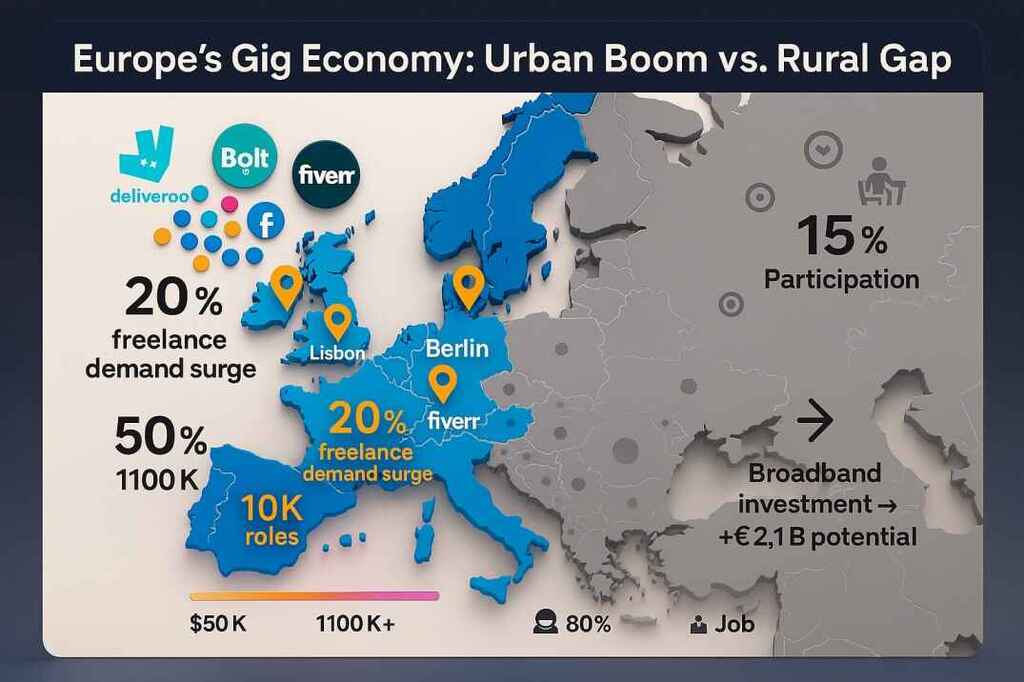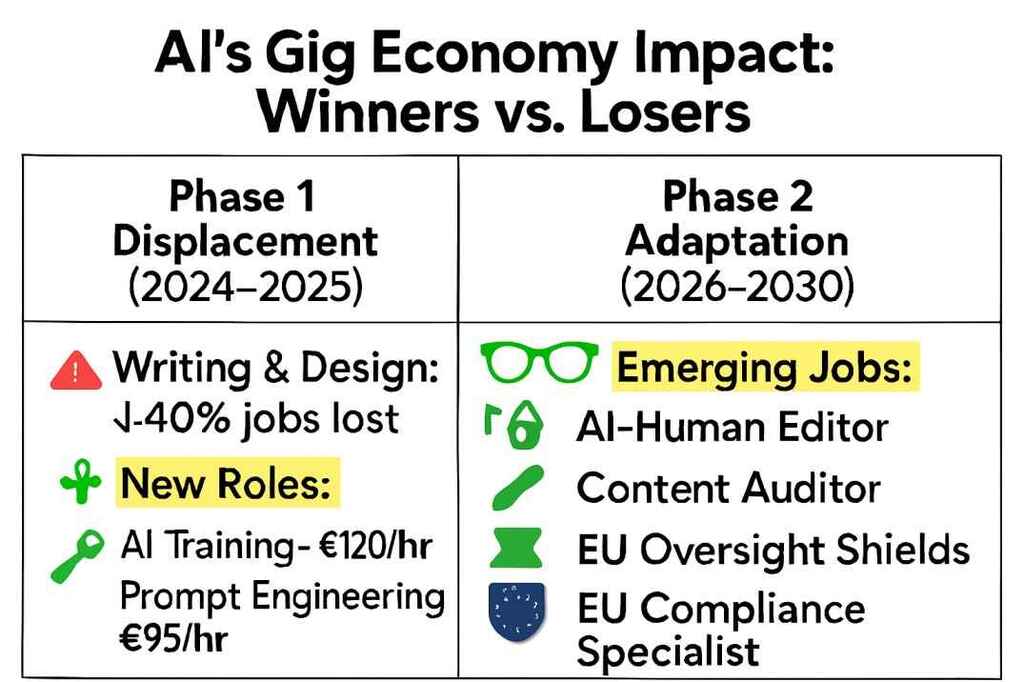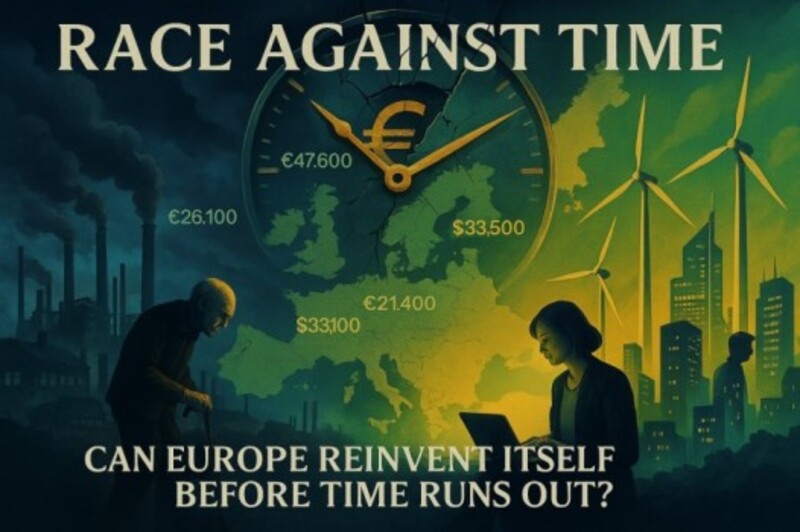 The image illustrates a projected split within Europe's gig economy in 2025 between traditional gig workers and AI specialists and earnings disparity. Image Credits: Mart Production via Pexels/AI
The image illustrates a projected split within Europe's gig economy in 2025 between traditional gig workers and AI specialists and earnings disparity. Image Credits: Mart Production via Pexels/AI
Europe’s Gig Economy Split [2025 Data]: 43 M At €15/Hour Vs. Ai Specialists At €120/Hr.
- Europe’s gig economy reached $7.35 billion in 2024, with a 20.8% annual growth rate projected through 2031 (European Parliament, Mc Kinsey 2024 Report, Cognitive Market Research).
- The platform workforce grew from 28.3 million in 2022 to an estimated 43 million by 2025 (Littler Mendelson P.C.)
- Cities like Berlin and Lisbon have 20% jumps in freelance demand, with fewer than half of those workers earning over $50,000, and just 13% crossing $100K annually.
-
70% of freelancers are under 35 and based in cities; only 15% of rural workers participate in gig platforms, with 80% still preferring traditional employment (World Bank).
- Rural freelancers face slow internet, limited digital confidence, and social expectations tied to traditional work.
"Bad Wi‑Fi kept me offline for months, only after NGO training did gigs become reliable."

- High-income roles like AI prompt engineering and model training are now paying up to €120/hour.
- Conversely,40% of writing and design gigs have been displaced by AI tools like ChatGPT (Solutions For Youth Employment, World Bank).
Anna, an Amsterdam-based designer, explains:
"Three clients vanished to AI tools in 2024. I had to pivot to AI-prompted design to stay competitive."

Fairness in the Algorithm Age: EU Rules in the Mix
- It legally presumes gig workers are employees under platform control, granting them rights to benefits and human oversight of automated decisions (Taylor Wessing, Crowell & Moring).
- Member states must transpose the law by December 2026.
- 54% of workers lack benefits like health insurance and paid leave.
- 38% earn between $10–$14.99/hour, while women earn 18–23% less
(Taylor Wessing).
The Persistent Gender Pay Gap: Why Women Earn Less in the Gig Economy
While the platform economy promises equal access, data reveals entrenched disparities:
18-23% earnings gap persists across major platforms (Taylor Wessing, 2024).
Structural causes:
- Algorithmic bias: Platforms prioritize "reliability metrics" that disadvantage women with care responsibilities.
- Gig segregation: Women cluster in lower-paid care/service roles while men dominate tech/transport.
- Bargaining disparity: Male freelancers negotiate rates 25% more often (Upwork internal data).
- Motherhood penalty: Algorithms interpret childcare gaps as "low availability".
Case Study: Uber's Successful Adjustments
Uber UK's 2022 reforms narrowed their gender earnings gap by 8% through:
- Blinded trip assignments: Removed driver gender from dispatch algorithms.
- Flex+ program: Paid waiting time for drivers with care responsibilities.
- Dynamic pricing caps: Limited surge pricing on school/hospital routes.
Contrasting Failure: Deliveroo's Algorithmic Shortfall
The food delivery platform's 2023 "Equity Mode" backfired when:
- Location-based bonuses intended to help women actually rewarded male cyclists in wealthy urban areas (LSE study, 2024).
- Peak-hour quotas for female riders led to account sharing with male partners.
- Customer tipping bias persisted, with male riders receiving 19% larger tips (Deliveroo internal data).
Key Lessons Emerging:
- Simple fixes fail: Gender-neutral algorithms often perpetuate existing biases.
- Local context matters: Solutions must address regional work patterns.
- Transparency is crucial: Workers need to understand how pay systems function.
Policy Solutions Gaining Traction:
- France's 2023 "Gig Equity Law" now requires bias testing before algorithm updates.
- Berlin's revised "Fair Crowdwork" program ties funding to verifiable pay equity gains.
- EU Directive Article 12 amendments will audit platform interventions annually.
Strategic Roadmap: Tailored Actions for the Gig Economy’s Future
Short Term (0–2 years):
- Improve algorithm transparency and simplify how pay is calculated.
- Introduce baseline pay guarantees and dispute resolution tools.
- Localize platform infrastructure to better serve rural and underserved regions.
- Launch skilling and certification programs in high-demand digital tasks (e.g., AI labeling, UX design).
- Develop hybrid platform ownership models that offer equity or dividends to workers.
- Integrate benefit systems (healthcare, pensions) directly into platform ecosystems.
- Invest in platforms with strong ESG alignment, labor transparency, and early compliance with EU regulations.
- Prioritize gig startups focused on financial inclusion, fair pay, and algorithmic accountability.
- Back ventures expanding into rural gig markets or developing AI-integrated freelance ecosystems.
- Support platforms offering portable benefits and career progression frameworks.
- Fund platforms pioneering cross-border labor solutions and multi-sector gig ecosystems.
- Encourage industry coalitions or investment vehicles that promote ethical AI use in labor matching and compensation.
- Begin transposing the 2024 EU Platform Work Directive into national law.
- Conduct regulatory audits on platforms to enforce worker rights, data use transparency, and pay equity.
- Build an EU-wide framework for portable benefits, including sick leave, retirement, and unemployment insurance.
- Incentivize digital infrastructure in rural areas to close participation gaps.
- Regulate AI and automated decision-making systems used by gig platforms.
- Harmonize platform labor laws across the EU to prevent a “race to the bottom” in worker protections.
Short Term (0–2 years):
- Join digital worker cooperatives or forums for legal support and bargaining power.
- Track income and hours to evaluate the sustainability of gig work and prevent burnout.
- Reskill in growth areas like AI prompt engineering, remote IT support, or project management.
- Explore creating personal brands and client rosters for more stable freelance income.
- Participate in shaping digital labor laws through advocacy or citizen assemblies.
- Transition into portfolio careers, combining gig work, consulting, and passive income streams.
.jpg)
A Stakeholder's Summary of Strategic Recommendations over the Short-term, Medium term and Long term
- Will rural communities gain real access?
- Can regulation keep up with platform innovation?
- Will tech-driven inequalities be addressed before they widen?
The gig economy is here. But the question remains: will it work for everyone?



